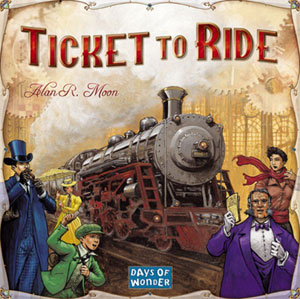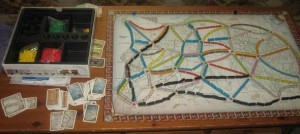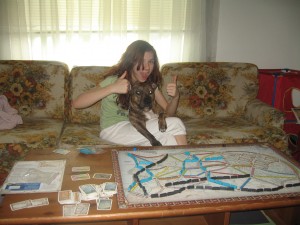If a train left Pittsburgh traveling 45 miles per hour going west and another train left Hawaii traveling 65 miles per hour going east, when would they meet? Unless the train from Hawaii has wings and flies like the one in Back to the Future 3….they won’t. Oh how I hated those problems in high school…luckily, you don’t have to deal with that chapter of math when you play Ticket to Ride.
In Ticket to Ride, players will be playing cards and laying down trains in between cities in order to make connections. As connections are made, players earn victory points. Players will also be given ticket cards that list two cities, which are usually a good distance from each other. Players receive bonus victory points for completing these routes and lose points if they fail to do so during endgame scoring. The object of the game is to have the most victory points after it is all said and done.
Components
Boards – The board is a map of the USA with cities listed on it. In between those cities are rectangular spaces that may or may not be filled with colors. Along the outside of the board is the scoring track.
Trains – These plastic trains help players keep track of what connections were made during the game.
Train Cards – These cards have colors on them, which are played to lay down trains onto the board and make connections.
Ticket Cards – These cards have routes on them, consisting of two cities and a point value. Players will be attempting to make the connections listed on these cards in order to score bonus points.
Scoring Tokens – These tokens are placed on the scoring track so that players can keep track of their score during the game.
Setup & Gameplay
Players pick a color and are given a bag of plastic trains, a scoring token, four train cards, and three ticket cards. Players then look through the ticket cards and can choose to discard one if they wish. Five train cards are drawn from the deck face up and are placed on the table as a pool to use during the game.
On a player’s turn, they may do ONE of the following:
A) Draw two train cards. You can draw one from the deck and one from the face up pool of train cards, you can draw two from the deck, or two from the face up pool. It’s important to note that should you pick up a wild card from the pool, you will not be allowed to draw a second card.
B) Draw three ticket cards. You decide which ones you wish to discard, if any, but must keep at least one.
C) Play cards to make a connection. To place your trains between two cities, you have to play the exact number of train cards from your hand of that color that connects the two cities. If there are five red rectangles between Pittsburgh and New York, for example, you’d need five red cards to place your plastic trains on those rectangles to make the connection. After this is done, move your scoring token up the appropriate amount on the scoring track. The cards you play are discarded.
When one player has two or less trains in his bag, one more turn is played by all of the players and the game ends. Players show their ticket cards and add victory points for every connection made and subtract victory points for every connection not made.
Editor’s Note: The above is simply an overview and doesn’t cover all of the rules in detail.
The Review
The average game plays out the same way ninety-nine percent of the time…draw train cards…draw train cards…make a connection and score points…draw train cards…draw train cards…make a connection and score points…draw train cards…draw train cards…draw train cards…etc. Players will sometimes draw ticket cards if they feel that they can make the new random connections the cards task them with before the game is over, but doing this is optional.
Ticket to Ride is a great game for kids and adults alike, despite its repetitiveness. The gameplay is fairly simple and turns go smoothly…that is…all you’re doing is either drawing to match like colors or placing like colors on the board to make connections. You aren’t managing stocks or trying to figure out if the D-20 you rolled entitles you to a critical hit because someone else played an interrupt card. For this reason, everyone in the house (with the exception of the person who hates board games) enjoys playing this game. The thirteen year old says that this is her favorite game to play, because it is “fun.” The ten-year old enjoys the whole “train theme” and making connections.
As for me, I enjoy it because of the strategy element. If I see one of the kids trying to make an obvious connection between two distant cities, for example, I may decide to make my own connections to block them. Players can’t make connections over someone else’s, meaning they have to make detours if they really wished to continue to make their original connection. Some city routes have dual connections to combat this. I enjoy the strategy of placing connections based on what my ticket cards require me to do without making it too obvious. Rather than form a long chain of trains, I’ll place a connection here and a connection there so that my route isn’t obvious until it is almost complete. By then, it’s usually too late for anyone to block me.
I highly recommend you give this a try, especially if you are looking for something new to play on family game night.
Editor’s Note: The pictures are old and do not represent my usual quality content…please be patient as I will eventually replace them as time permits.
Final Verdict: 10/10
—



